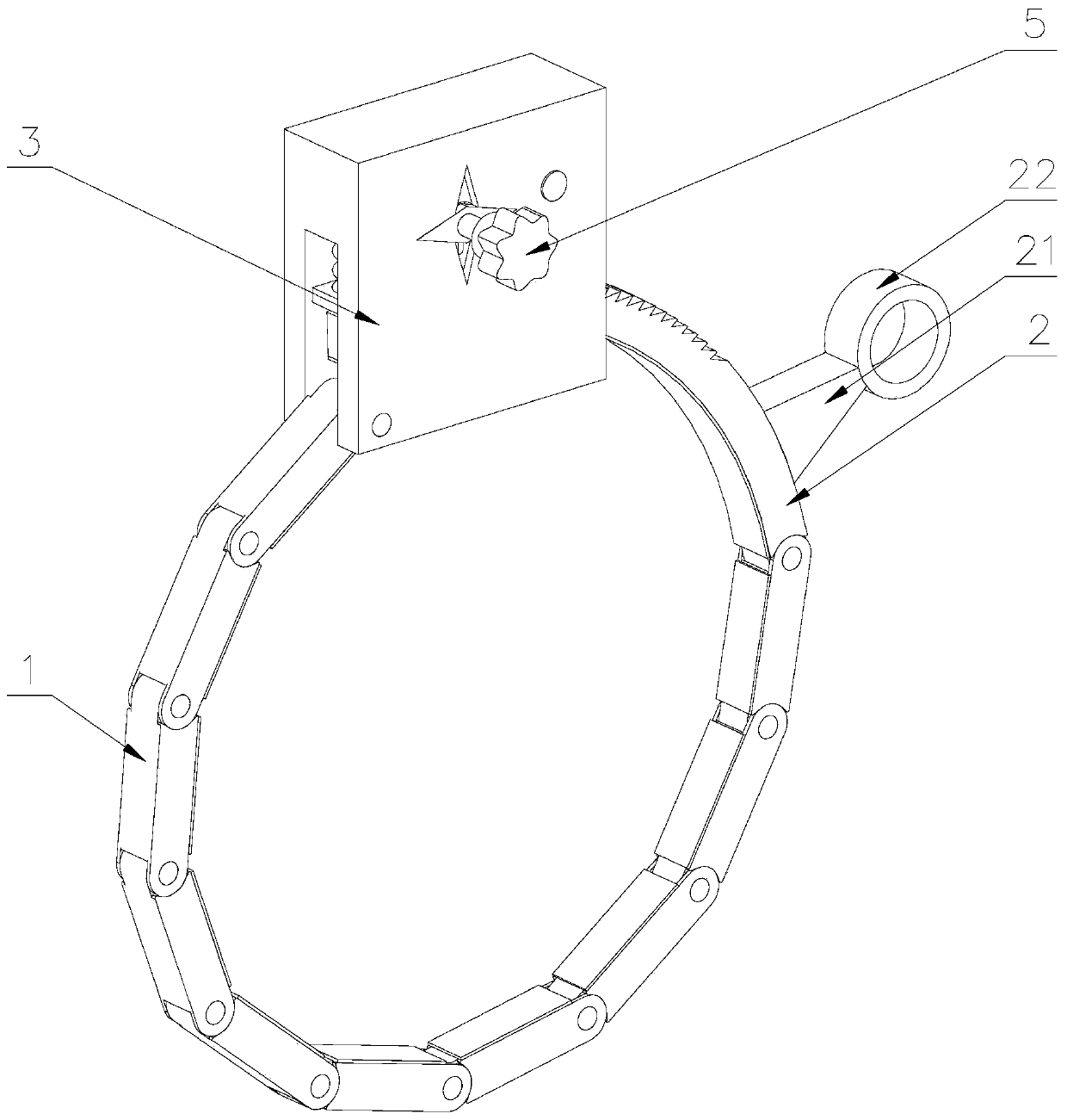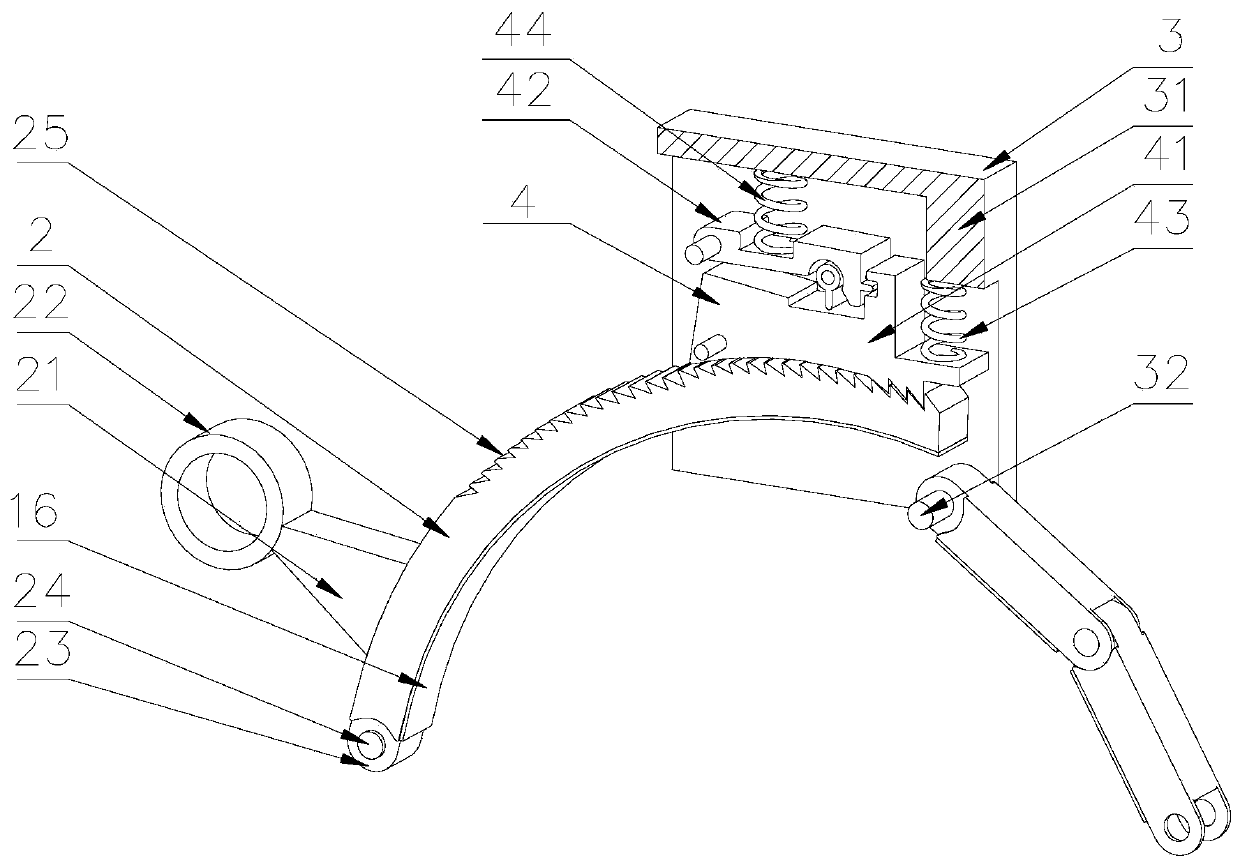Device capable of preventing strand scattering during wire cutting
A wire and anti-scattering technology, which is applied in the field of electric power construction auxiliary equipment, can solve problems such as unfavorable wire cutting, achieve the effects of improving efficiency and safety, improving stability, and avoiding loose strands
- Summary
- Abstract
- Description
- Claims
- Application Information
AI Technical Summary
Problems solved by technology
Method used
Image
Examples
Embodiment 1
[0047] A wire cutting anti-strand device, including a first connecting arm 1, a second connecting arm 2, a first shield 3, a locking mechanism 4, and an unlocking device 5, the first connecting arm 1 is provided with several groups, the One end of the first connecting arm 1 is provided with a first groove 12, and both sides of the first groove 12 are provided with a clamping plate 11, and a connecting hole 13 is provided on the clamping plate 11; One end is provided with a first hinged joint 14, and first pin shafts 15 are provided on both sides of the first hinged joint 14, and the first pin shafts 15 are movably connected with the connecting holes 13 on the clamping plate 11; multiple sets of first connecting arms 1. The first pin shaft 15 and the connecting hole 13 are sequentially connected to form a flexible connecting arm. When crimping the wire, a circular gap is formed between the first connecting arm 1 and the second connecting arm 2, which increases the gap between th...
Embodiment 2
[0055] The difference from Embodiment 1 is that the locking mechanism 4 includes a rotating shaft 46 and a rocker 48, a second shield 6 is provided on one side of the first shield 3, and one end of the rotating shaft 46 is movably installed on the second On one side of the shield 3, the other end of the rotating shaft 46 is movably installed on one side of the second shield 6; the rotating shaft 46 is fixedly equipped with a second ratchet 47, and the second ratchet 47 is located on the first shield. Inside the cover 3, and the ratchet 25 of the second ratchet 47 is matched with the ratchet 25 of the second connecting arm 2; a first ratchet 45 is provided on one side of the second ratchet 47, and the first ratchet 45 is located on the second Inside the shield 6; the rocking bar 48 is positioned at one side of the second ratchet 47, and the lower end of the rocking bar 48 is fixedly installed on the rotating shaft 46, and one side of the upper part of the rocking bar 48 is provi...
Embodiment 3
[0059] The difference from Embodiment 1 and Embodiment 2 is that when the wire clamping device is used together to cut the middle section of the wire, in order to ensure that the wire is in a tight state, a connecting device 7 is provided between the two sets of wire clamping devices. The device 7 includes a stud 71, the first connecting rod 22 is provided with a through hole, the stud 71 is located inside the through hole, a first nut 72 is provided on one side of the first connecting rod 22, and the first connecting rod 22 is provided with a first nut 72. The other side of the connecting rod 22 is provided with a second nut 73. According to the needs of the construction site, adjust the distance between the two groups of clamping devices, and make the wires in a tight state. The position of the wire clamping device is fixed to ensure that the wire is in a tight state, which not only improves the efficiency of wire cutting, but also ensures the safety of construction; in order...
PUM
 Login to View More
Login to View More Abstract
Description
Claims
Application Information
 Login to View More
Login to View More - R&D
- Intellectual Property
- Life Sciences
- Materials
- Tech Scout
- Unparalleled Data Quality
- Higher Quality Content
- 60% Fewer Hallucinations
Browse by: Latest US Patents, China's latest patents, Technical Efficacy Thesaurus, Application Domain, Technology Topic, Popular Technical Reports.
© 2025 PatSnap. All rights reserved.Legal|Privacy policy|Modern Slavery Act Transparency Statement|Sitemap|About US| Contact US: help@patsnap.com



